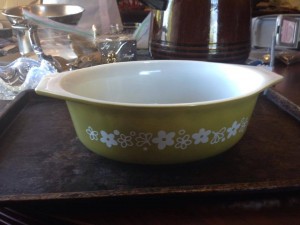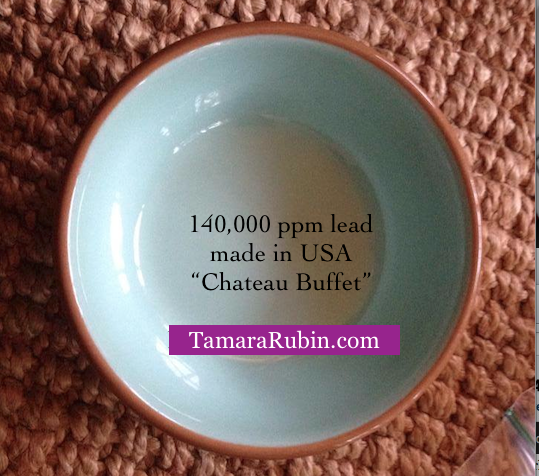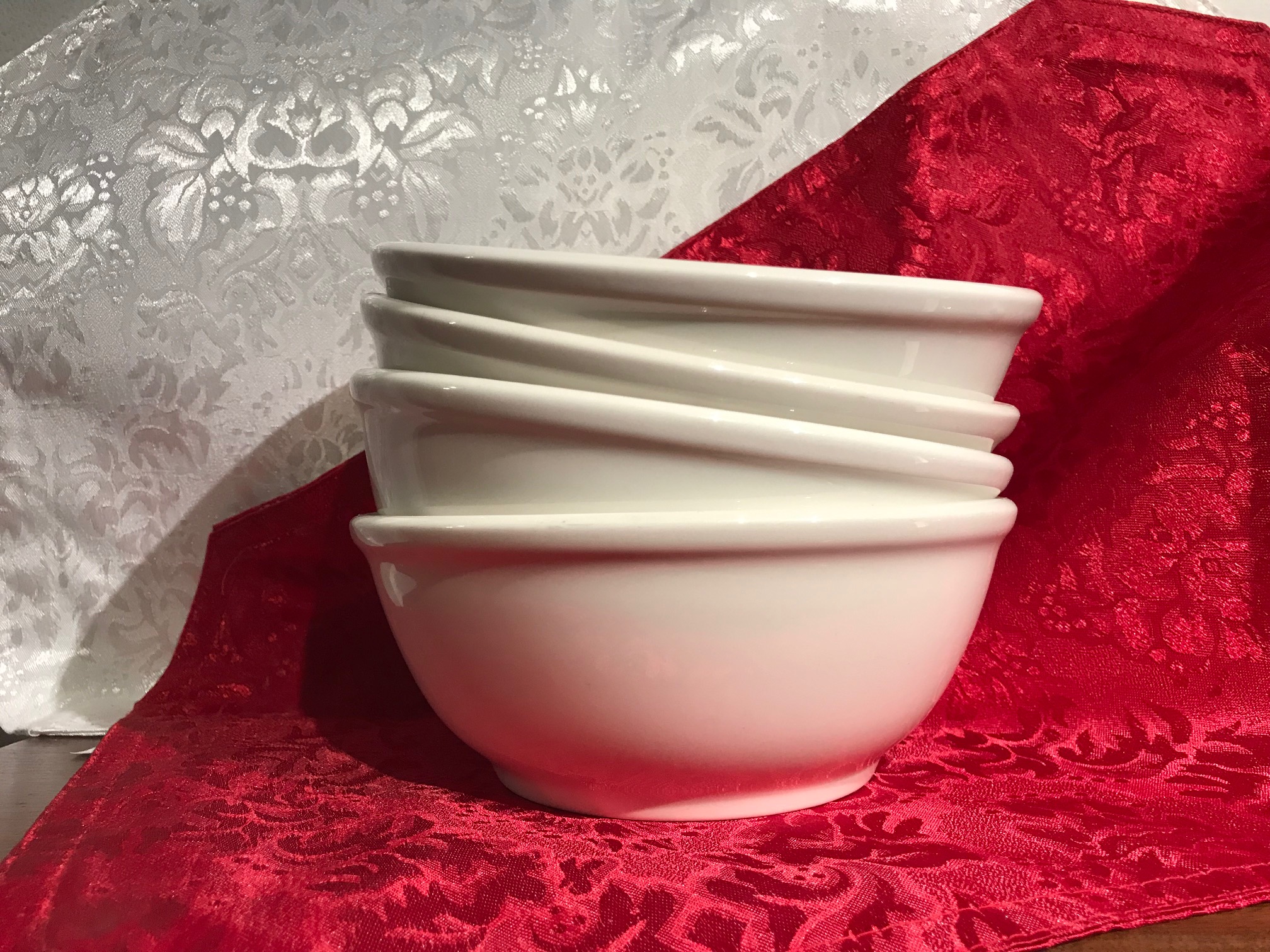Does vintage and new functional pottery and dishware have unsafe levels of lead? Why is that a problem?
Question: Does vintage and new functional pottery and dishware have unsafe levels Of lead? Why is that a problem?
Originally Published: August 18, 2013
Updated: December 28, 2019
Answer: Pottery & dishes often contains lead.
For decades potters have known about the potential hazards of lead in ceramics and glazes and many have chosen to specifically seek out lead-free source materials and produce lead-free pottery.
I have intimate personal experience and knowledge of this fact…
True story: I was born in 1969, and and during my childhood my mother made groovy pottery and ceramic wind chimes which we all sold in our groovy booth at the many groovy festivals and street fairs that characterized that groovy era!
My mother’s famous pottery (she sold at Disney World and Filene’s and her pieces were actually featured in museum exhibits and she was a student of Peter Voulkos at U.C. Berkeley in the early 1960s) was my family’s primary source of income for more than 20 years. Knowing what I know now, and with the technology and tools I have at my disposal today – I tested some of the pottery I still have that my mother made when I was young – and it is all lead-free. <Sigh of relief!>
If you are buying from a local artist you can always ask them if they use lead in their clay or glazes.
Some of today’s more progressive ceramic artists (like my good friend Greg of Ceramic Generations in San Anselmo, CA) who make their pottery vessels specifically for eating off of and cooking with will mark “lead-free” on the bottom – so that is something to look for as well.
What about pieces that are not handmade by reputable ceramic artists in the United States?
Outside of the realm of handmade pieces, where you can actually talk to the artist – all bets are off.
While there are some regulations (including most notably Prop 65 in California) that include provisions designed to create awareness of potential toxicity in consumer goods or directly protect consumers from lead-toxicity (for example some legislation includes standards for leach-testing of ceramics “used for food preparation and consumption”), there are no U.S. regulations (to my knowledge/correct me if I am wrong!) that specifically regulate the overall total content of lead in pottery (as detectable with an XRF instrument)—even for pottery pieces intended for use with food and beverages.
The only exception to this is if an item is explicitly “intended for use by a child” (like a ceramic baby cup.) In that case, there are two standards for determining toxicity (total lead and surface/coating lead) but as a rule-of thumb I cite the more strict of the two standards (which is also in-line with European toxicity standards) – with my recommendation that an item intended for children should not be more than 90 (ninety) parts per million lead.
That said, I have tested pottery (with a Niton XRF instrument that I am trained and certified in using) that was as high as 400,000 ppm lead! This is pottery that was ostensibly sold as a dish to eat off of. I have also tested new/modern pottery that I was told was “leach tested and determined to be safe”—pottery that was in the 40,000 to 50,000 ppm range.
To see more items I have tested with an XRF instrument, click here.
There is no rule of thumb as to whether modern or antique china or pottery will have lead. Some “experts” will tell you that, “heavily decorated pottery has more lead”, however – as recently as earlier this week – I have found heavily decorated modern pottery from Mexico with 100 ppm lead, and plain white pottery from England with 80,000 ppm lead – which just reinforces that there is no way to determine lead content by such apparent empirical observations—you just can’t make assumptions.
For me this brings up a big question—about the effectiveness of leach-testing as a sole basis for determining safety.
To check out some of the vintage china I have tested, click here.
I tell people that for my family I don’t consider there to be some “safe level” for lead in our dishes and pottery. Period. No acceptable level of lead. It just takes a microscopic amount of lead to poison a child and it is not worth the risk.
How do I (or you) as a consumer know if an item was leach tested or not? [We generally don’t! – This information is not always easily accessible to the public.]
With many pottery products today there may not even be a manufacturer’s mark on the bottom, so you have no one to call, no place to start your research. Also there are very few manufacturers who actually advertise their pottery or dishes as lead-free or lead-safe.
To check out some of the ceramic mugs I have tested, click here.
And then – and this is my primary set of concerns:
- What happens as these ceramic pieces and their glazes age and chip and crack and craze? 20, 30 or 40 years from now? (or even 5-years from now with heavy usage)?
- Does the leach-testing stand the test of time for any particular piece?
- If just one sample batch of a product was leach-tested, what assurances do you have that the batch your piece came from was made with the same standards? fired at the same temperature? made with glazes and substrates with the same proportions of ingredients?
- With heavy usage, acidity (tomato sauce, lemon juice, vinegar, etc.), microwaving?, dishwashers?, heavy cleaners? does the surface eventually break down and start leaching? Did their leach-testing account for excessive use and wear?
- At what point does that 40,000 ppm (or 140,000 (!) – see the dish above) eventually become unsafe?
- Where will the company be then?
- Who is going to do the leach-testing on these dishes after they have started deteriorating.

Which brings us around to the fact that NO antique or vintage pieces have been leach-tested as a group, with current standards and science in mind, by their makers. (Again – correct me if I am wrong about that!)
The government (the CPSC) has no jurisdiction over antiques and collectibles. They don’t think of your grandmother’s pots, pans, casseroles and china as a risk that needs to be considered. They don’t take into account that you are using them every day to cook for your family. They cannot and will not issue a recall on a product made in 1954.
And this doesn’t even address this question:
Do we really want/need to keep mining lead and refining lead and disposing of lead, with all the attendant pollution, occupational exposure, poisoned communities and environmental degradation—for the alleged benefits to some manufacturers that it may confer—when we know that ceramics can obviously be and are commonly made these days without any lead??
Also this question:
Do we really want to continue to use vintage and antique dishware and leaded crystal that can potentially poison our families (especially when we know today you can buy modern dishware that is completely safe!?)
[Go IKEA! – nearly everything I have tested from IKEA has been either lead-free or below 90 ppm lead!]
These reasons and more are why I advocate for lead-free pottery and dishes REGARDLESS of what federal standards and policies are, regardless of what companies are telling you about the leachability of toxicants in a certain product or product line.
There.Is.No.Safe.Level.Of.Lead. Period.
What should I do if my ceramics are positive for lead? Click here.
People cherish these things. They hold on to them as family heirlooms and pass them on to their children and grandchildren.
I don’t want to even consider passing something on to my grand-kids if there’s a chance it could be toxic now or become toxic in their lifetime.
Do you?
Tamara (& Len)
Never Miss an Important Article Again!
Join our Email List






Hi, I sent a message on IG but just in case you didn’t see it, I’m asking here.
I recently did a heavy metals provocation urine test and many metals came by high, lead and aluminum being two.
We use Jacobson Salt liberally on our food.
I asked them about the custom made pots they use. They are stainless steel coated in aluminum. I then asked about their 3rd party testing levels on aluminum. It is “1960 pub to a LOQ of 400ppb. (I have no idea what this means.) In your opinion is this level ok?
Thanks so much! Kim
So sorry-this is not about PNB, didn’t know where else to post.
I see you say above that most of what you have tested from ikea is lead free – are you including their ceramic bakeware in that as well?